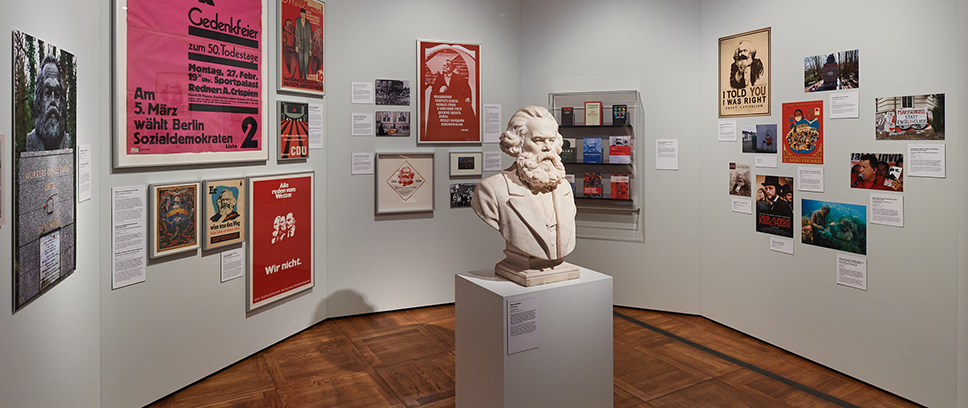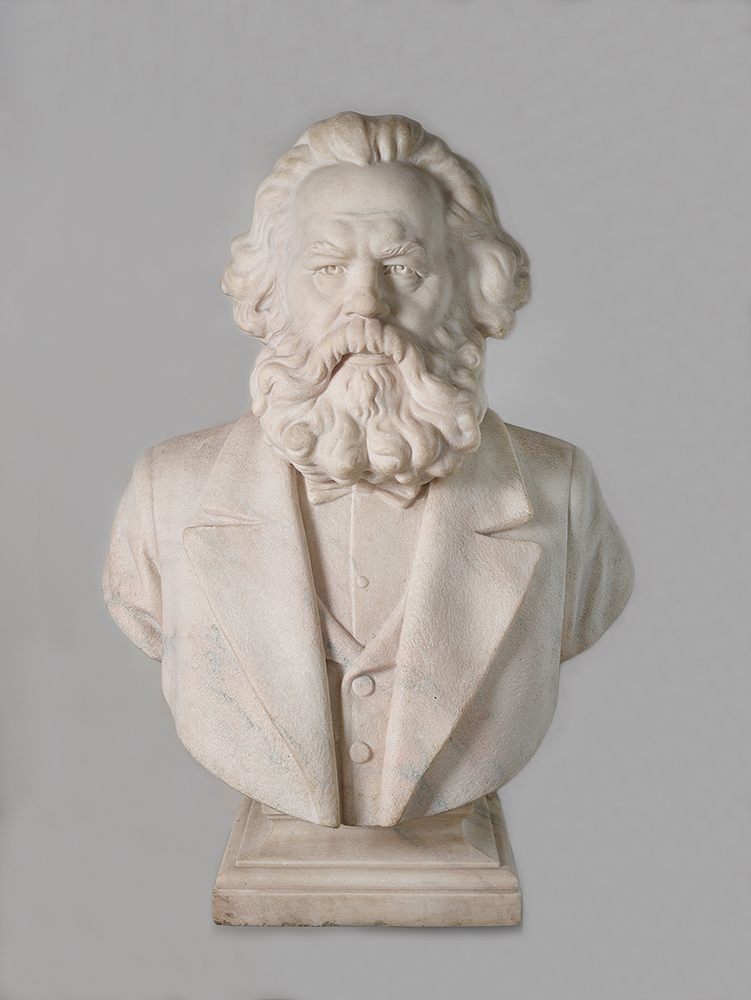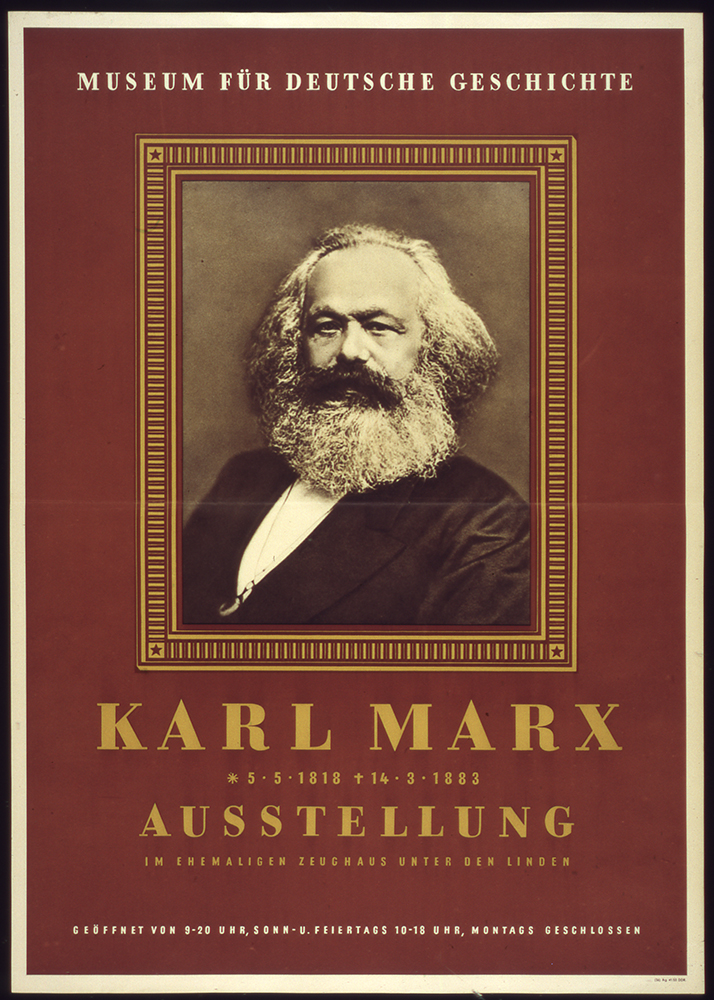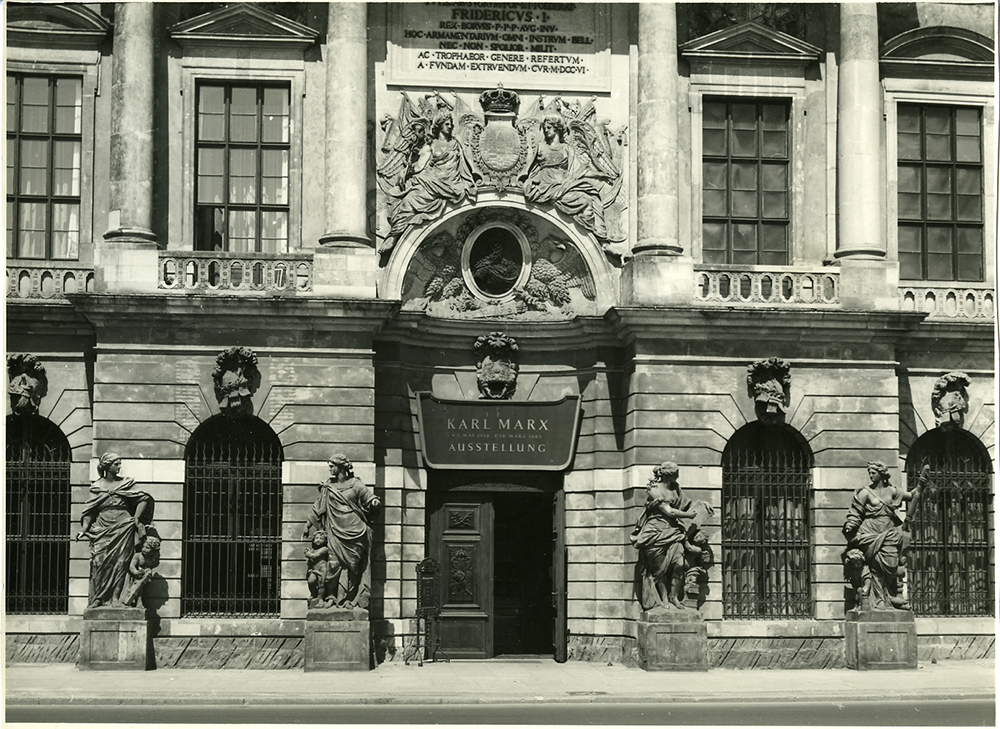
What’s that for? Bust of Karl Marx
Michael Ilg | 8 June 2022
The 217-kilogram marble bust of Karl Marx was designed by the Romanian artist Constantin Baraschi (1902–1966). As part of the exhibition “Karl Marx and Capitalism”, it raises questions about the reception of Karl Marx and the history of the Deutsches Historisches Museum. Michael Ilg, academic trainee and part of the exhibition team, tells us more about the bust.
The sculptor Constantin Baraschi, born in Câmpulung (Romania) in 1902, studied in Romania and France and was later appointed professor at the Institute of Fine Art of the University of Bucharest. Prior to the First World War he treated the topics of mythology and Christianity in his artistic works. After Romania had come under Russian influence and joined the Warsaw Pact, he quickly advanced to one of the most important representatives of Socialist Realism in the country.[1] His bronze statue of Lenin and Stalin was presented by Vasile Luca, deputy premier of Romania, to the German Democratic Republic as an official gift on the occasion of the second anniversary of the founding of the GDR on 7 October 1951. It testifies to the role of Baraschi as an exemplary artist of the young People’s Republic of Romania. Today this statue is in the collection in the Deutsches Historisches Museum.
The bust shown in the exhibition “Karl Marx and Capitalism” is evidence of the use of Marx as a “stone icon” in socialism. Baraschi produced it in 1953. The marble portrait of Marx measures nearly a metre high. Its shiny surface sometimes even glistens. It shows the man from Trier dressed in a shirt, vest and slightly open jacket, and sporting a full beard at an advanced age. Baraschi’s Marx stares strictly straight ahead, revealing no emotions except for grave wrinkles on his brow.

The bust came to the GDR in the so-called Karl Marx Year of 1953, celebrated on the occasion of the 70th anniversary of the death and 135th anniversary of the birth of Karl Marx. It was shown as one of four busts of the philosopher in one of the first exhibitions of the Museum für Deutsche Geschichte (MfDG), the national history museum of the GDR, shortly after it was founded. The Marx presentation was opened on 2 March 1953 in the rooms of the former Zeughaus, in Berlin. Arranged in 44 rooms, the exhibition showed where Karl Marx and Friedrich Engels had lived and worked as well as the “further development” of their teachings in the Soviet Union. The exhibition served not only to present the life and work of Marx, but also aimed to stylize the GDR as the heir to the “greatest son of the German people”.[2]

In the foreword of the exhibition catalogue, the director of the Museum für Deutsche Geschichte, Prof. Dr. Alfred Meusel, stressed the aim of the show: “The Marx exhibition should not only give the visitor an understanding of the Marxist values, but also aims to encourage him to participate […] in a gigantic transformation process, which, through the works of Marx and Engels, leads socialism from utopia to science and was realised in the work of Lenin and Stalin.”[3]
Alongside a great number of busts and statues, the exhibition also contained many other objects. It presented rare documents on the history of the German labour movement, first editions of the “Manifesto of the Communist Party” and of “Capital” as well as private objects that had belonged to the Marx family. A great number of staff members participated in the preparations for the exhibition. Replicas of numerous historical objects, such as a copy of a printing press from the time of the Rheinische Zeitung, gave the exhibition a lively appearance. In the first half of the year 1952, Walter Ulbricht had already informed Mikhail Andreyevich Suslov, Secretary of the Central Committee of the Communist Party, that an exhibition would be opened in Berlin on the occasion of the “Marx Year”. He requested of Suslov not only help in procuring photographs and documents, but also the fabrication of an exact copy of the chair in which Karl Marx died.[4]

Not only the participation of Romania is evidence of the international importance that the exhibition enjoyed among the communist states of Eastern Europe. On 25 March 1953, Walter Ulbricht thanked the Central Committee of the Communist Party of the Soviet Union for sending replicas of furniture from the possessions of Marx with the words: “We convey to you our heartfelt thanks for the armchair, working chair and bookcase of Karl Marx. This generous support is an exceptionally meaningful contribution to the realisation of the […] Karl Marx Year, especially for the design of our Karl Marx exhibition.”[5]
References:
[1] Mocanescu, Alice Carmen Rodica, The leader cult in communist Romania 1965-1989: constructing Ceauescu’s uniqueness in painting, Durham theses, Durham University 2007. Online: http://etheses.dur.ac.uk/2571/, p. 89f.
[2] Museum für Deutsche Geschichte (ed.), Karl Marx. p. 5. 1818 -14.3.1883. Exhibition in the former Zeughaus Unter den Linden, Berlin 1953, p.8.
[3] Ibid.
[4] Hecker, Rolf, Die Herausgabe von Marx/Engels-Schriften zwischen erster MEGA und MEW (1945–1953), in:: Die Marx-Engels-Werkausgaben in der UdSSR und DDR (1945-1968), Hamburg 2006, pp. 13-55, p. 52.
[5] Cit. from: ibid.
Michael IlgSince May 2021 Michael Ilg has worked at the Deutsches Historisches Museum as an academic trainee in the area of exhibitions. He studied history, focusing on South Eastern European history and Jewish history, at the Universities of Augsburg, Prague and Poznań. |